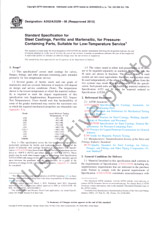We need your consent to use the individual data so that you can see information about your interests, among other things. Click "OK" to give your consent.
ASTM E3179-18
Standard Test Method for Determining Antimicrobial Efficacy of Ultraviolet Germicidal Irradiation against Influenza Virus on Fabric Carriers with Simulated Soil
Translate name
STANDARD published on 1.10.2018
The information about the standard:
Designation standards: ASTM E3179-18
Note: WITHDRAWN
Publication date standards: 1.10.2018
SKU: NS-945478
The number of pages: 6
Approximate weight : 18 g (0.04 lbs)
Country: American technical standard
Category: Technical standards ASTM
The category - similar standards:
Annotation of standard text ASTM E3179-18 :
Keywords:
This test method describes the steps required to deposit influenza virus onto fabric carriers., antimicrobial, decontamination, Germicidal, influenza virus, microbicidal, ultraviolet, UV-C, UVGI,, ICS Number Code 07.100.01 (Microbiology in general)
Additional information
| Significance and Use |
|
5.1 This test method determines the effectiveness of UVGI devices for reducing viable microorganisms deposited on carriers. 5.2 This test method evaluates the effect soiling agents have on UVGI antimicrobial effectiveness. 5.3 This test method determines the delivered UVGI dose. |
| 1. Scope |
|
1.1 This test method defines test conditions to evaluate ultraviolet germicidal irradiation (UVGI) light devices (mercury vapor bulbs, light-emitting diodes, or xenon arc lamps) that are designed to kill/inactivate influenza virus deposited on inanimate carriers. 1.2 This test method defines the terminology and methodology associated with the ultraviolet (UV) spectrum and evaluating UVGI dose. 1.3 This test method defines the testing considerations that can reduce UVGI surface kill effectiveness (that is, soiling). 1.4 Protocols for adjusting the UVGI dose to impact the reductions in levels of viable influenza virus are provided (Annex A1). 1.5 This test method does not address shadowing. 1.6 The test method should only be used by those trained in microbiology and in accordance with the guidance provided by Biosafety in Microbiological and Biomedical Laboratories.1.7 This test method is specific to influenza viruses 1.8 The values stated in SI units are to be regarded as standard. No other units of measurement are included in this standard. 1.9 Warning—Mercury has been designated by many regulatory agencies as a hazardous substance that can cause serious medical issues. Mercury, or its vapor, has been demonstrated to be hazardous to health and corrosive to materials. Use caution when handling mercury and mercury-containing products. See the applicable product Safety Data Sheet (SDS) for additional information. The potential exists that selling mercury or mercury-containing products, or both, is prohibited by local or national law. Users must determine legality of sales in their location. 1.10 This standard does not purport to address all of the safety concerns, if any, associated with its use. It is the responsibility of the user of this standard to establish appropriate safety, health, and environmental practices and determine the applicability of regulatory limitations prior to use. 1.11 This international standard was developed in accordance with internationally recognized principles on standardization established in the Decision on Principles for the Development of International Standards, Guides and Recommendations issued by the World Trade Organization Technical Barriers to Trade (TBT) Committee. |
We recommend:
Updating of laws
Do you want to be sure about the validity of used regulations?
We offer you a solution so that you could use valid and updated legislative regulations.
Would you like to get more information? Look at this page.




 Cookies
Cookies
